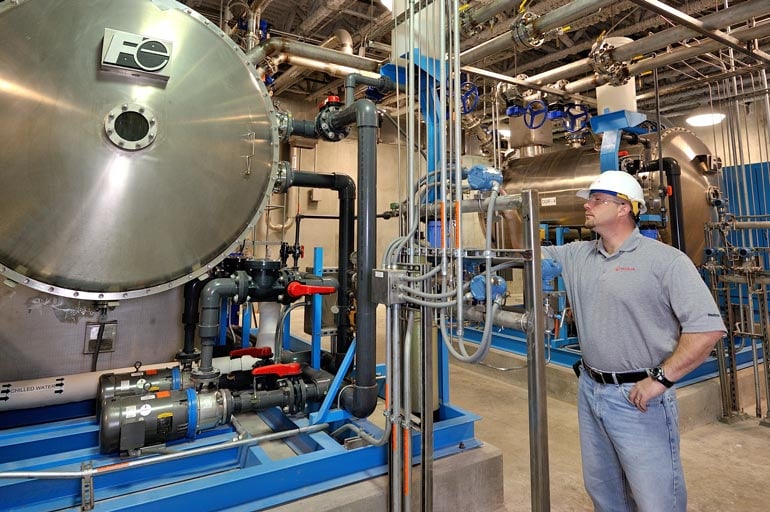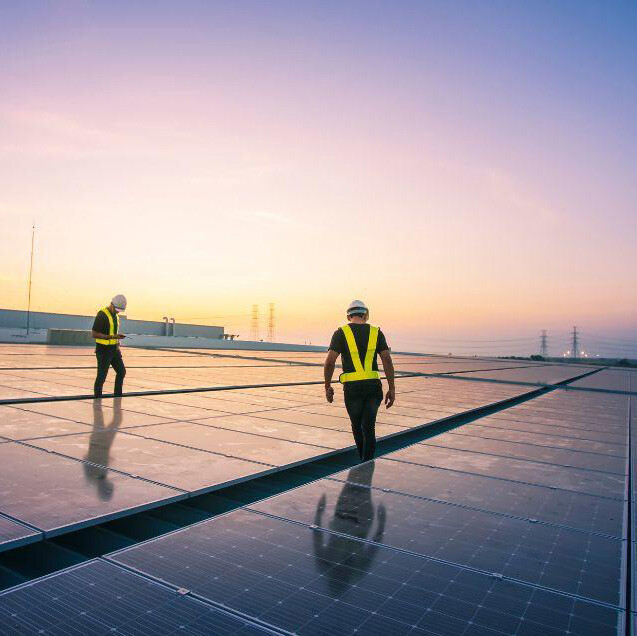The surge in natural disasters and drought related to climate change in recent years has led many municipalities across the country to accelerate efforts to reduce greenhouse gas (GHG) emissions and invest in resiliency measures. In addition, there has been a wave of federal investment into infrastructure at a time when energy prices are highly volatile and policy is evolving to accommodate a more electrified world.
Municipal wastewater plants may be the most practical jumping-off point for cities to implement high-impact initiatives to not only reduce costs and emissions but also increase resiliency.
Water-energy nexus: the problem and opportunity
Wastewater treatment solutions consume tremendous amounts of energy. According to the EPA, for many municipalities across the United States, water facilities account for 30 to 40 percent of their total energy consumed. The link between water and energy is known as the water-energy nexus.
Every step of the water cycle — from producing, moving and treating water to collecting, treating and reusing wastewater — uses a large amount of energy. In the US, drinking water and wastewater treatment systems represent 2% of GHG emissions (adding over 45 million tons of greenhouse gases to the environment every year).
Investing in energy efficient and renewable technologies to improve operational performance presents a significant opportunity for local governments to reduce their operating costs, cut their emissions and build the critical infrastructure that cities need to thrive.
Strategies for sustainable wastewater treatment solutions
Moving towards renewable energy isn’t just about reducing carbon emissions and cutting energy costs – it’s also about becoming more energy independent and resilient to ensure uninterrupted service and safety. A major piece of any municipal decarbonization program involves assessing the current condition of essential city infrastructure and developing strategies to modernize the systems on which our communities depend every day.

Generate power on-site
Wastewater facilities that utilize anaerobic digesters have the ability to generate renewable energy. Anaerobic digestion is the process by which bacteria break down organic matter sludge in wastewater. Wastewater treatment plants that accept source-separated organics like food slurry and fats, oils, and grease for co-digestion can experience compounded benefits of avoiding the landfilling of those organic waste streams while boosting their biogas production and serving as community sustainability hubs.
Biogas created by anaerobic digestion can then be used as fuel in a process called cogeneration to produce reliable electricity on-site and supplement the facility’s energy needs, or it can be conditioned to pipeline quality renewable natural gas and exported for use by the local community.
Implement renewable energy sources
In addition to biogas, wastewater treatment plants can also cut down their use of fossil fuels by utilizing solar, wind or fuel cells. Facilities can either build and operate the technology on-site, purchase renewable energy from the power grid or purchase renewable energy certificates (RECs) to power their wastewater treatment solutions.
In addition, wastewater treatment plants tend to be campus-style facilities with large footprints that are ripe for deployment of renewable energy and energy recovery systems such as influent or effluent heat exchangers.
Utilize microgrids
Microgrids, or self-sufficient, localized energy systems serving a discrete geographic footprint, are commonly used to generate on-site power and ensure system resiliency and redundancy simultaneously. Microgrids often leverage multiple distributed energy resource technologies, including solar photovoltaic, biogas, wind, fuel cell, internal combustion and hybrid resources with battery storage to maximize efficiency of the system.
In this way, microgrids have the potential to renewably power 100% of a municipality’s wastewater treatment facility’s electricity needs. By incorporating multiple distributed energy resources (DERs) into one localized, self-sufficient system, city facilities are able to operate even in power outage or brownout situations. Microgrids are a key part of future sustainable cities.
Replace hazardous chemicals
Chemical disinfection is costly. By replacing this process with UV light disinfection, plants can eliminate the need to dispose of hazardous chemicals like chlorine.
Implement data management solutions
Supervisory Control and Data Acquisition (SCADA) provides real time data on the treatment processes in your plant. By continuously monitoring operation and usage trends, plant managers can identify opportunities to reduce energy use and more accurately predict future consumption patterns to optimize plant efficiency.
Real world examples of sustainable wastewater solutions
Rialto, California — The City of Rialto partnered with Rialto Water Services and Veolia to explore a microgrid powered by renewable energy: a combination of biogas cogeneration, solar power, and battery storage systems. The project would save the city an estimated $355,440 per year in energy costs.
Government incentives for updating wastewater treatment solutions
Two recent federal laws have made funds available to municipalities and local governments who want to implement sustainability and renewable energy projects related to water:
- The Infrastructure Investment and Jobs Act (IIJA)
- The Inflation Reduction Act (IRA).
Taken together, both of these laws have made available nearly $2 trillion in federal dollars for updating infrastructure and reducing greenhouse gas emissions. It’s now possible for municipalities across the country to implement projects to improve the water-energy nexus.
The next step for your municipality
Reducing greenhouse gases, increasing long-term sustainability, and ensuring residents have continuous access to clean water and a safe environment are key objectives for municipalities. Addressing the water-energy nexus and limiting negative environmental impacts is a lofty but attainable goal. Identifying high-impact projects is a crucial first step.
Looking to decarbonize your municipal wastewater plant? Contact us.



